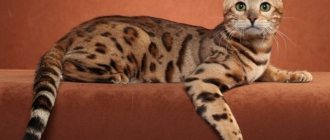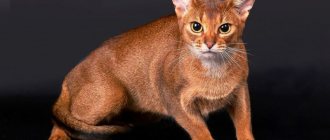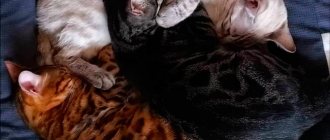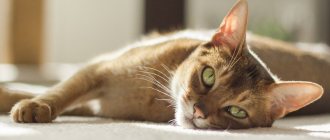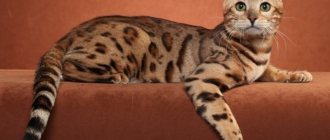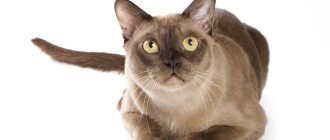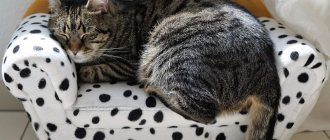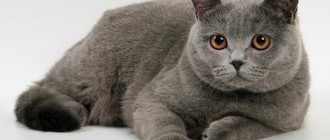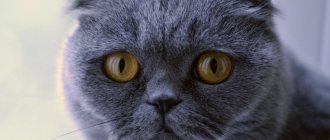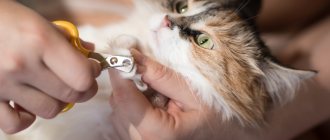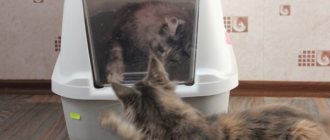Unique and unpredictable mestizos
Metis is the result of crossing cats of different breeds. Or outbreds. In general, any cats without a pedigree are called mestizos. They inherit the best qualities of their parents: endurance, intelligence, health. Among the mestizos, no two cats are alike. Each of them has a unique appearance. What purebred representatives of cat breeds cannot boast of.
Metis are the most common cat breed on earth.
Mestizos are very diverse. It is possible to predict the temperament and appearance of a cat only if it was born in a nursery or at home and the parents are known. The kitten inherits behavioral patterns from its father and mother. The character of mestizos depends on their upbringing and habitat. Life experience is what shapes the personality of a half-breed. If a mixed breed of an elite breed is raised and nurtured as an aristocrat, he will exhibit traits inherent in the breed. And when a cat has to fight for his life, all manifestations of character will be aimed at survival.
The history of cohabitation between humans and cats goes back more than 10 thousand years. In ancient times, cats were not distinguished into separate breeds. Depending on the region of residence, climate, and nutrition, they had different appearance and character traits. Later, with the development of navigation, it became possible to mate cats from different regions. Then the first mestizos appeared.
Felinologists were divided into two camps. Some breeders do not recognize mestizos as full-fledged cats and mercilessly cull them. Others, on the contrary, consider mixed cats smarter, more educated, more resilient than purebred cats and endowed with properties unattainable for aristocrats.
Mixed breeds do not meet breed standards, so they are not sold. Or they charge a symbolic price. A gifted kitten is believed to bring good luck.
Where to buy a purebred cat of an elite breed?
The best option, without a doubt, would be to contact specialists who have Bengal and British kittens in their nurseries. Buying a purebred cat in a cattery in Moscow means being sure that it will grow into a magnificent representative of its breed. At the Viola Alba nursery, breeders raise and supervise the best representatives of the British and Bengal breeds. They will not only help you choose a kitten that suits your personality, but will also help in raising it. There are both British and Bengals in the kennel. The Moscow nursery can also cooperate with residents of the regions closest to Moscow, providing them with support in the proper care of elite pets.
Diversity of mestizos
All felinological associations prohibit mating between breeds. Each species has distinctive characteristics that disappear during uncontrolled reproduction. Belonging to a particular breed is determined by genotype and phenotype. That is, according to the set of genes inherited from the parents and external characteristics (body size, color, coat length, skull structure).
Maine Coon mixes
Officially, breeding Mei-Coon mixes is prohibited. In fact, there is no control over cat lovers. Unscrupulous owners cross Maine Coons with other breeds or ordinary cats. As a rule, culled individuals participate in such breeding. Serious breeders do not allow such animals to mate. Owners who purchase “defective” animals from nurseries are required to castrate or sterilize them. Large fluffy kittens are sometimes offered under the guise of purebred Maine Coons. Dishonest owners try to sell them inexpensively, explaining the discount for various reasons.
Maine Coon and Siberian cat mixes can be very beautiful
A purebred Maine Coon is expensive. Wanting to save money, cat lovers buy Maine Coon mixes in the hope that they will inherit the qualities of a purebred animal. Distinctive character traits of Maine Coon cats are:
- sociability, goodwill towards people, friendliness;
- calmness, balance;
- self-esteem;
- absence of pronounced aggressive habits;
- high level of intelligence.
In fact, a Maine Coon mixed breed cat and a purebred cat are completely different cats. Breeders worked for several decades to create and consolidate the original characteristics of the breed. Not a single mestizo will fully comply with the standards of behavior. It is impossible to predict what the character of a mature cat will be. As a result of illiterate crossbreeding, aggression may appear and poor health may occur.
British cat mixes
Uncontrolled crossing of the British cat with the Scottish Fold almost led to the degeneration of both breeds
Not everything is so simple with English cats. First of all, do not confuse the British Shorthair and the Scottish Fold. The breeds are related, but completely different. Scottish Folds (Scots) are descended from the British as a result of mutation of the ears. Strictly speaking, these are mestizos from crossing fold-eared cats with British ones. It took more than half a century for the Scottish Fold to gain independent status from a spontaneous breed.
In 2004, a ban was introduced on the crossing of Scottish Fold and British cats.
The appearance of a huge number of mestizos when crossing the British and Scots led to the gradual degeneration of both breeds. In 2004, a law was passed banning their mixing. For the same reason, in 2003 it was prohibited to cross Persian and British cats.
Mixed bengal cat
The Bengal cat is a mestizo who has become an aristocracy. This is a cross between a domestic and Asian leopard cat. To stop the barbaric export of exotic Bengals from their historical homeland, enthusiasts bred a stable breed with a wild appearance and gentle character.
Crossing Bengal cats with other breeds is prohibited by all felinological associations . Therefore, there are no officially recognized mestizos of this breed. That doesn’t stop owners who aren’t too scrupulous from pairing Bengals with other cats. As a result, smaller mixed breeds with inappropriate colors appear. The second generation completely loses the characteristics of the breed.
As a result of crossing the Bengal cat with other breeds, the characteristics of the breed are lost
Recently, the long-haired Bengal has been gaining popularity. With all the characteristics of the breed, they have long hair, a fluffy tail and a collar.
If earlier, in order to avoid damage to the breed, breeders of such kittens sterilized, now a long-haired Bengal cat is valued more than a traditional Bengal.
Persian cat mixes
Persians are considered the most common cat breed in the world. And in terms of the number of colors they have no equal. It is not surprising that there are a huge number of Persian cat mixes. The Persian-British hybrid has become widespread. A crossbreed with an ordinary domestic cat is often found. Among connoisseurs, mixed breeds of Scottish Fold (Scottish Fold) and Persian are valued.
Persian cats are used as a basis for developing new breeds
Persians are the progenitors of many cat breeds. The exotic cat is very popular. In appearance it is a Persian with short hair. Breeders do not stop there. Taking the Persian breed as a basis, they gave the world such cats as:
- Napoleon (a cross between a Persian and a Menchkin with short legs);
- Himalayan (Persian with Siamese coloring);
- Cherub (curly-haired Selkirk Rex with a Persian face);
- Tiffany (a hybrid with the Burmese breed, which has obtained unusually soft, silky wool);
- Iranian cat and Tonkaline (hybrids bred by adding genes of the Tonka breed);
- Alaskan snow cat (alliance of Somalia and White Persians).
And these are just some of the derived cat breeds.
Interspecific crossing, as a rule, does not affect the health of mixed offspring. However, there is a risk of genetic diseases.
Tested by cats
Having extensive experience in keeping cats of different breeds, I can confidently say that mixed breeds navigate dangerous situations much faster than purebred cats. Especially on the edge of life and death. Under these conditions, the natural instincts inherent in the genes awaken in half-breed mestizos. Elite mestizos activate the best survival mechanisms inherent in breeds.
There were two cats in our apartment at the same time - a purebred Persian and a cross between a Siberian cat and an ordinary domestic cat. The aristocratic Persian cat, despite his arrogant and proud disposition, unconditionally recognized the primacy of the Siberian Timokha. Although he was larger and two years older. Never approached the food bowl first. He allowed himself to be bathed only after he saw with what pleasure his Siberian brother took water procedures. Both cats were long-haired and required constant care. If the mestizo Timofey endured the combing process patiently and calmly, then in order to comb the elite Persian, he had to wrap his hands in a terry towel to avoid injuries from teeth and claws.
The diet was also significantly different. The Siberian mixed breed was an omnivore; there were no problems with feeding it. We had to develop a special menu for the Persian, taking into account the cat’s food preferences and the advice of the veterinarian.
Now I have a mixed breed of Maine Coon and an ordinary cat. Fluffy philosopher and intellectual fighter. I believe that interspecific crossing, especially spontaneous or illiterate, weakens and worsens the genotype. To obtain hardy, healthy and intelligent offspring, a rush of “wild” blood is necessary.
Choosing a mixed-breed cat
Every cat is unique. But experts believe that by external signs - the shape of the skull, body structure, color and length of fur - it is possible to predict the character traits of a pet from a very young age. And even a predisposition to disease. Mixed breeds of elite cats inherit from their parents the appearance and behavior pattern characteristic of a particular breed. When choosing a mestizo, you should pay attention to the main phenotypes. Try to determine from them what character the cat will have and its future health problems.
"Marquise" phenotype
Short, black fur with white spots. The body constitution of cats is dense, while that of cats is thin. This phenotype is characteristic of short-haired European breeds. These pets have a stable, predictable character. They demonstrate their desires quite clearly. They try to manage the house and achieve their goal with affection or perseverance. They have good health. With poor nutrition, urolithiasis can develop.
Phenotype "Siberian cat"
The color is gray-striped. The coat is long with a thick undercoat. The body is loose or dense. The head is large, round, with a protruding muzzle. Confident, independent character. These animals are “on their own.” They skillfully put the owners in the desired place and show who is boss in the house. They accept affection solely of their own free will. They don't like it when they are bothered with attention. May experience digestive problems. Suffer from obesity, diabetes, urolithiasis,
Angora cat phenotype
Long or semi-long light coat. Dry, tender body. Elegant, light head. Having an independent disposition, they show miracles of devotion and trust in the owner. Sensing the weakness of the owner, they can show “savagery” and aggressiveness, defending themselves and protecting the territory. They need daily human contact. The owner is expected to be predictable and stable. Health is good. Problems with respiratory function and infections are possible.
"British" phenotype
The coat is dense and short. The head is round, large, with erect ears. The body structure is rough and dense. Tabby and blue-gray color. The tail is thick, with transverse stripes. Independent character. Showing displeasure, they can be stubborn and aggressive. These cats are not easy to handle. Touching is allowed, guided solely by one’s own mood. They often become “masters of masters.” Like all cats with a rough constitution, they have a tendency to chronic kidney diseases and obesity. And also, endocrine system disorders and chronic pancreatitis.
Phenotype "Persian cat"
The coat is long, silky, without coarse guard hairs. The head is round, the nose is flattened. The body constitution is rough or loose. They have an independent character and position themselves as a decoration for the home. They can be capricious and demanding. Persians and mestizos are often cut like a lion. Since long hair needs to be combed, and Persians do not like this procedure. Predisposed to diseases of the genitourinary system and upper respiratory tract.
Phenotype "oriental cat"
A cat with short, delicate fur. Thin, dense skeleton with developed muscles. The body is elongated. Quite heavy with an elegant appearance. Light, graceful head. Large or medium movable ears. The color is varied: spotted, solid, striped, color-point, tabby and others. Due to their focus on the owner and the need for constant communication, they are called “cat-dogs”. Orientals have irrepressible energy. Need active games. If energy is not used, obesity may begin. They strive to restore order in the house. Health is quite good. They may have digestive problems and infections.
Phenotype "Thai cat"
Semi-long or short coat of characteristic colors: blue point, seal point, lilac tabby point, lilac point. The head is round. Eye color is blue. Strong, graceful cats with a dense, but not coarse constitution. The character is even, non-conflicting. The behavior model is close to that of a dog. They need constant contact with the owner. They are acutely aware of his mood swings. Empathizing with the problems of the owners, they can get sick. They are very persistent in achieving their goals. They achieve their goals not through arrogance and aggression, but through persistence and affection. Health is quite good, but they are susceptible to urolithiasis and slow infections.
Taking into account the external signs of the pet, it is possible to predict the future character and behavioral model. Take measures for proper education and prevent possible diseases.
Estimation of breed characteristics
| Adaptability: |
| Shedding level: |
| Social need: |
| Grooming: |
| Ease of care: |
| Attachment to family: |
| Hair loss/shedding: |
| Health/susceptibility to disease: |
The selective breed of Bengal cats, which appeared a little more than half a century ago, has a unique color and special disposition. So far, the small population in the world is in demand and is actively developing. A Bengal cat of any color looks very exotic.
Reviews from owners of mixed-breed cats
People pay a lot of money for purebreds in order to brag about it to their relatives or friends. Or people buy expensive animals with the prospect of making money on it, for the purpose of further breeding and resale. As for intelligence and ingenuity, it’s possible! After all, breeders develop cat breeds not only based on the external qualities of the breed, but also on the internal ones: mental stability, aggressiveness, ability to train, etc. It is difficult to judge, because in one litter of even the most thoroughbred there can be different specimens with different psychos. qualities. The same can be said about mestizos. My opinion is that all cats are almost equally smart and smart. Everything will depend on the conditions of their detention and, of course, the actions of the owner (training).
binom[9.1K]
About the mixed breed of the Bengal cat
My kitten Semyon is the son of a Bengal cat and a simple yard cat Vaska. Outwardly it does not look like a runaway, except for its spotted sides.
About character and behavior: the cat is very capricious, it is not possible to wean him from anything, neither shouting nor slippers, nor a spray with water have any effect. The cat climbs all over the apartment, tables, chests of drawers, closets, not a single place in the house where he has not been; when he opens a drawer, he will certainly look in there and climb in. If you want to sit in the toilet and poop, he will definitely come in with you and climb on the toilet while you perform the act of defecation. You go to the shower, the cat will sit on the washing machine and watch. In general, a cat is like a dog, always with you, no matter where you are, the only exceptions are when he sleeps, and he sleeps when you and your wife are at work, so when you come home you will always be in the company of the cat, you won’t even be able to eat alone , he will be nearby.
The cat has a hard time with loneliness; when he comes home, he rejoices and rolls around in a ball on the floor, then begins to purr and lick his lips. When you are lying on the bed, he comes up and starts licking your lips and mouth, begging for saliva (I don’t know why).
The cat is mega active, not wrong, HE’S MEGA ACTIVE! If he starts running and playing hiding! With acceleration, he jumps up, pushes off the wall with his hind legs, doing a triple sheepskin coat with a flip, rushes to another part of the apartment, at your feet he sees a wounded partridge that can be gobbled up. If you start playing with him, then he is in the process of flirting and begins to fight strongly, he can skin his hands well, his teeth are sharp as needles, and he bites painfully.
If he needs your attention, then he will achieve it, for example: our cat knows that you can’t touch the tree, you are lying on the sofa, and the cat wants to eat or play, he comes up to the tree and starts fiddling with it, knowing that you will stand up and fulfill his lusts.
The cat loves to eat tightly and is not picky about food (he shits very smellily!).
He drinks water from our glass that stands next to the filter.
He pisses and poops only in a closed tray, after his dirty deeds he runs around for several minutes as if scalded.
He loves heights; while you are cooking or washing dishes, he will watch you from the upper cabinets of the kitchen set (he first climbs onto the table-refrigerator-set). Yesterday I slept on the closet (I jumped onto the ironing board from it onto the closet).
The cat makes different sounds: meows, quacks, quacks, beeps, etc.
Before this, there were outbred cats, calm and melancholic, but this cat’s behavior does not resemble them at all.
Bottom line: if you like to just eat quietly after work and binge-watch the TV or smartphone, God forbid, don’t adopt this breed. I had moments when I regretted being so careless about choosing a kitten.
Characteristics of British kittens
Breeders select healthy individuals without genetic or other abnormalities, with a stable psyche and a friendly attitude towards people.
By purchasing an animal without documents, you risk purchasing a pet with diseases of various origins, weak immunity, or encountering unpredictable behavior. Because a breed is not only a name and appearance, but also a character.
British cats need constant attention, which is important for people who are outside the house all day. With a self-sufficient and independent character, British cats are not aggressive in critical situations and are not prone to attacking people.
From birth, the British are clean and almost immediately get used to the tray and scratching post.
As for the appearance of the British, they are easily recognizable among others. British cats are classic representatives of the semi-cobby type. This body type includes the following characteristics:
- strong and short wide-boned body;
- short rounded paws:
- powerful short neck;
- a large round head with cheeks that resemble jowls;
- erect ears with soft rounded tips;
- Their nose (British cats), wide from the bridge of the nose to the tip, has a depression;
- large round eyes;
- short tail with thickening at the base and rounding at the end.
Thus, the British is a collection of soft, rounded shapes. All physical parameters are strictly regulated, so deviations from them are considered a violation of the standards and result in the cat being rejected.
But in addition to their special memorable appearance, these cats have good hereditary characteristics. With proper care, they have virtually no health problems, and their life expectancy ranges from 12 to 20 years.
It is widely believed that a British cat can be distinguished from its relatives of another species by its eye color. This is not an exact sign, since a kitten’s eye color can only be fully determined by the first year of life.
In addition, eye color is tied to coat color and this must be taken into account when choosing a pet, as well as the fact that the presence or absence of certain traits is genetic.
Genes are divided into dominant and recessive, which means that no matter how beautiful blue eyes look, they are rare among British cats. After all, the gene for blue eyes is recessive, that is, it is suppressed by others.
What else is unique about Bengal cats?
Along with the specific patterns we've discussed for spotted and marbled cats, there are other differences unique to Bengals that may help you if you're still unsure...
One of the most beautiful unique characteristics of the Bengal cat is the shine (or glitter) of its coat . It looks so elegant, but is so hard to capture in a photo!
The golden glow of a brown Bengal or the effect of pearl dust on a Bengal's light fur must be seen in person to be fully appreciated. Here's a photo showing the glitter effect:
glitter on a bengal cat
There are other aspects of the Bengal's coat that are also unique - it is often said that you can identify a Bengal cat by touching it while blindfolded. Some find the best way to describe the Bengal's fur is that it is more pelt-like than fur-like, with its satin or silk feel while being short and plush.
The normal tabby cat's fur often "ticks" whereas a Bengal's should not - the ticking is where each strand of hair is broken up into different stripes of color.
Besides the fur and wool, which we have focused a lot on, there are other characteristics of the Bengal breed that, when you put them all together, make Bengals a uniquely beautiful cat.
The Bengal's body is large, slender and muscular, with strong bones. Its hind legs are slightly longer than its front legs, reminiscent of their wild ancestors. The head is relatively small in relation to the body with medium to small ears. The Bengal's tail is thick and can be ringed, spotted or marbled, but should always have a dark colored tip. The chin should be light and the mustache should be prominent. The nose is large and wide.
Even the Bengal's voice is different from most other cats. You probably know if you have a Bengal cat in your neighborhood because Bengals often loudly remind their owners about it throughout the day!
Differences in coat quality and color
There are two types of British cats: British Shorthair and British Longhair.
The classic color is blue (gray). Moreover, the color of the coat and undercoat must match.
Because of this feature, British cats are often confused with Russian blue cats. However, after carefully studying the standards of both breeds, it becomes clear that these are different animals.
Meanwhile, breeders are working to create new color options for cats without losing other standards of the species. Today there are already white, red and black colors, as well as many shades, for example, British reds are divided into red (bright red) and cream (peach).
At what age will the difference be clearly visible?
The characteristic appearance of the British breed distinguishes them from representatives of other breeds even at a very young age. However, only an adult, mature individual can be checked for compliance with the standards. Then we can say whether it is a purebred cat or a crossbreed.
Depending on the breed, the age at which a cat is considered an adult also varies. Bengal cats take 9 months to fully mature, Maine Coons take 2 years.
The British breed is considered mature at 12 months of age. Around this time, all processes associated with changes in coat and eye color are completed.
Health and diseases of Bengal cats
The health of Bengal cats is considered a complex topic. The breed, on the one hand, has strong genes from wild forest ancestors, but on the other hand, it was formed through closely related breeding, and this has a negative effect. Generally speaking, Bengal cats suffer from only a few typical diseases, as discussed in the corresponding three sections “Diseases and Health”, “Puberty of the Bengal”, “What you need to know about castration of a cat”. You can prevent the likelihood of pathologies by monitoring the condition of the animal, undergoing annual or as needed examinations from a veterinarian, and vaccinations (vaccinations), sterilization or castration done on time.
Read more about the health of Bengalis
Is it possible to identify a Briton by his behavior?
There are also standards for the behavioral characteristics of a cat. The British are calm and clean pets, aristocrats from the cat world, so many people choose this breed due to its character.
These animals are not prone to hooliganism and find peaceful activities in the absence of their owners, for example, playing with specially designated objects or sleeping. They are easy to train to the litter tray and scratching post.
But every cat is an individual. It has its own behavioral characteristics and adapts to the requirements and conditions in which it finds itself. At the age of a British kitten, it is easy to distinguish from others by external signs, but their behavior is no different from other kittens.
They are just as active, playful and inquisitive, and only closer to the age of one year they become more sedate and independent of communication.
Keeping and caring for Bengal cats
The great advantages of Bengal cats and cats include their undemanding maintenance. Having purchased a basic set of cat supplies and taken care of two or three scratching posts, you won’t need anything else “special”. The second advantage is short, non-shedding hair, which should only be combed from time to time. The Bengal easily gets accustomed to water procedures and household routines - he will not refuse to bathe. Read more about caring for Bengal cats here.
Read more about keeping and caring for Bengals
Grooming of Bengal cats
Like other short-haired breeds, Bengal shorthairs do not need a haircut, and brushing the coat is an infrequent procedure (once every 2 weeks), washing is even less common. However, this descendant of forest predators has strong, sharp claws - they must be trimmed even when actively walking, or if there are claw sharpeners with different textures in the house. The animal is removed with sharp tweezers only from the very tip of the already bent claw. The pet should be in a complacent and relaxed state at this time. If you injure your cat (by touching living tissue), you should immediately moisten the claw with hydrogen peroxide.
The purring ears' small ears need regular cleaning of wax - the easiest way to do this is with a cotton swab soaked in petroleum jelly.
The expressive eyes of the Bengal cat require washing from time to time, and if there is excessive mucus secretion or souring of the eyes, veterinary care is needed.
To avoid gingivitis (inflammation of the gums), brush your teeth about once or twice a week with a special cat toothpaste.
Simple procedures, and most importantly, attention to the well-being of the tailed pet, guarantee a magnificent appearance for the Bengal.
What to feed a Bengal cat
The pet’s quality of life – health, exterior beauty, longevity – is directly dependent on a competent and varied diet. Bengalis, who have sensitive stomachs, find it difficult to experiment with food items and cooking methods. Cheap economy food for an expensive cat is nonsense. There are two (main) options: high-quality food prepared by an industrial brand or balanced natural nutrition. You need to be very careful with this breed in a mixed menu. Read more in the article “Feeding Bengal cats.”
Natural nutrition
With all the advantages included in the concept of “natural products,” there are disadvantages: keeping track of a balanced diet is not easy. The entire list of vital ingredients in a cat’s diet will have to be tracked using a specially kept diary. A complete list of dishes and additives in them is in the detailed article “Feeding”.
Ready food
The very definition of “ready-made food” makes the task of properly feeding a Bengal cat 90 percent easier. It is important to observe portion sizes and frequency of meals. The manufacturers have thought about, weighed, and calculated the balance of branded food (Bengals shouldn’t even offer anything else!).
Features of feeding
In addition to the usual age-related features of feeding babies and feeding adults, Bengal cats have a tendency to have poor tolerance to a number of foods and general instability of the functionality of the gastrointestinal tract. Therefore, it is recommended to very carefully offer animals new natural and canned products, and to transfer the food menu from one manufacturer to another according to the scheme (see the text “Feeding”).
Read more about feeding Bengals
